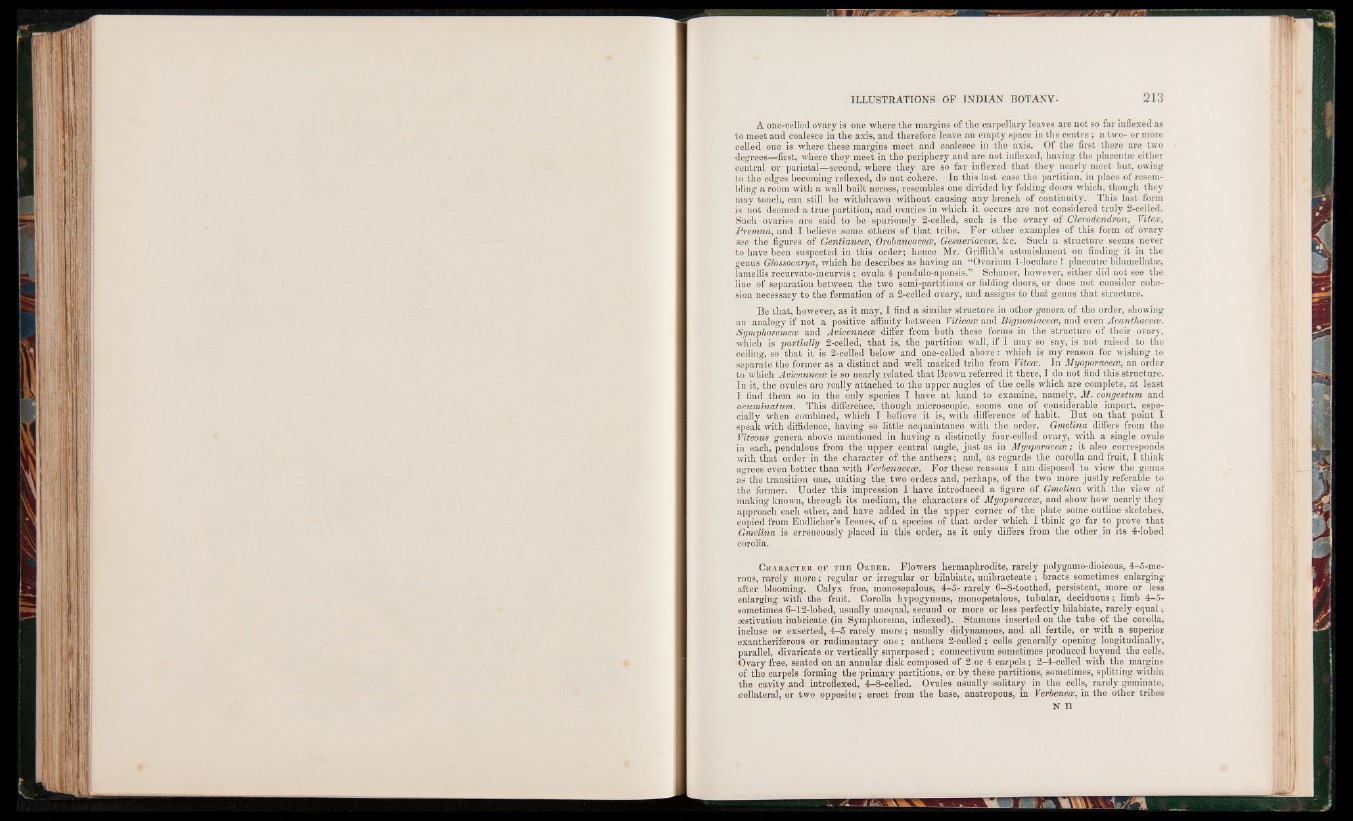
A one-celled ovary is one where the margins of the carpellary leaves are not so far inflexed as
to meet and coalesce in the axis, and therefore leave an empty space in the centre; a two- or more
celled one is where these margins meet and coalesce in the axis. Of the first there are two
degrees—first, where they meet in the periphery and are not inflexed, having the placentae either
central or parietal—second, where they are so far inflexed that they nearly meet but, owing
to the edges becoming reflexed, do not cohere. In this last case the partition, in place of resembling
a room with a wall built across, resembles one divided by folding doors which, though they
may touch, can still be withdrawn without causing any breach of continuity. This last form
is not deemed a true partition, and ovaries in which it occurs are not considered truly 2-celled.
Such ovaries are said to be spuriously 2-celled, such is the ovary of Clerodendron, Viteat,
Premna, and I believe some others of that tribe. For other examples of this form of ovary
see the figures of Gentianece, Orobancacece, Gesneriacece, &c. Such a structure seems never
to have been suspected in this order; hence Mr. Griffith’s astonishment on finding it in the
genus Glossocarya, which he describes as having an “Ovarium 1-loculare ! placentas bilamellatas,
lamellis recurvato-incurvis; ovula 4 pendulo-apensis.” Schauer, however, either did not see the
line of separation between the two semi-partitions or folding doors, or does not consider cohesion
necessary to the formation of a 2-celled ovary, and assigns to that genus that structure.
Be that, however, as it may, I find a similar structure in other genera of the order, showing
an analogy if not a positive affinity between Viticece and Bignoniacece, and even Acanthacece.
Symphoremece and Avicennece differ from both these forms in the structure of their ovary,
which is partially 2-celled, that is, the partition wall, if I may so say, is not raised to the
ceiling, so that it is 2-celled below and one-celled above: which is my reason for wishing to
separate the former as a distinct and well marked tribe from Vitece. In Myoporacece, an order
to which Avicennece is so nearly related that Brown referred it there, I do not find this structure.
In it, the ovules are really attached to the upper angles of the cells which are complete, at least
I find them so in the only species I have at hand to examine, namely, M. congestum and
acuminatum. This difference, though microscopic, seems one of considerable import, especially
When combined, which I believe it is, with difference of habit. But on that point I
speak with diffidence, having so little acquaintance with the order. Gmelina differs from the
Viteous genera above mentioned in having a distinctly four-celled ovary, with a single ovule
in each, pendulous from the upper central angle, just as in Myoporacece; it also corresponds
with that order in the character of the anthers; and, as regards the corolla and fruit, I think
agrees even better than with Verbenacece. For these reasons I am disposed to view the genus
as the transition one, uniting the two orders and, perhaps, of the two more justly referable to
the former. Under this impression I have introduced a figure of Gmelina with the view of
making known, through its medium, the characters of Myoporacece, and show how nearly they
approach each other, and have added in the upper corner of the plate some outline sketches,
copied from Endlicher’s leones, of a species of that order which I think go far to prove that
Gmelina is erroneously placed in this order, as it only differs from the other in its 4-lobed
corolla.
C h a r a c t e r o f t h e O r d e r . Flowers hermaphrodite, rarely polygamo-dioicous, 4-5-me-
rous, rarely more; regular or irregular or bilabiate, unibracteate; bracts sometimes enlarging
after blooming. Calyx free, monosepalous, 4-5- rarely 6—8-toothed, persistent, more or less
enlarging with the fruit. Corolla hypogynous, monopetalous, tubular, deciduous; limb 4-5-
sometimes 6-12-lobed, usually unequal, secund or more or less perfectly bilabiate, rarely equal;
aestivation imbricate (in Symphorema, inflexed). Stamens inserted on the tube of the corolla,
incluse or exserted, 4-5 rarely more; usually didynamous, and all fertile, or with a superior
exantheriferous or rudimentary one; anthers 2-celled; cells generally opening longitudinally,
parallel, divaricate or vertically superposed; connectivum sometimes produced beyond the cells.
Ovary free, seated on an annular disk composed of 2 or 4 carpels; 2-4-celled with the margins
of the carpels forming the primary partitions, or by these partitions, sometimes, splitting within
the cavity and introflexed, 4-8-celled. Ovules usually solitary in the cells, rarely geminate,
collateral, or two opposite; erect from the base, anatropous, in Verbenece, in the other tribes
n n